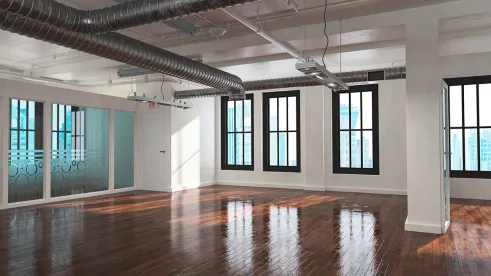A panel of commercial real estate leasing experts shared their predictions and updates for major Western region markets at the 14th Annual View From the Top. Panelists included Jeffrey Welch, Executive Vice President of CBRE; Christopher T. Roeder, Executive Managing Director of JLL; David Sternberg, Executive Vice President of Northern California & Mountain Regions of Brookfield Properties; and David Abbot, Executive Vice President of Colliers. The panel was moderated by Allen Matkins partner Tony Natsis.
The panelists agreed that the number one priority at the moment is getting people back to work in the office—a sentiment also shared by tenants and property owners. Overall, the outlook remains positive in the leasing market.
LOS ANGELES
Los Angeles saw the second-lowest occupancy in the country during the COVID-19 pandemic. The massive 235 million square foot market has seen rents increase in five of the last six quarters despite the fact that the city has been shut down for the last 18 months and vacancy rates are as high as 40%. Driving the rent increases are 12 million square feet of new space scooped up by the tech industry.
There have been pockets of activity in Culver City, Burbank, and Hollywood mostly related to the booming techtainment industry in the area. Demand for entertainment has remained high, increasing the need for soundstages and the like.
In contrast, the downtown Los Angeles market has been stagnant, as the companies that traditionally occupy those spaces have stayed home. These finance, real estate, and insurance companies continue to perform well, but there is some speculation that they will need less space after the pandemic ends.
Across all markets in the Los Angeles area, concessions are at all-time highs. There is no indication that these concessions will fall or rental rates will drop in some of the less popular areas. Moving forward, landlords and tenants are looking for flexibility and efficiency. Flexibility is key, as tenants may not know exactly what they need until they get everyone back in the office and are able to see how they want to use their space.
SAN FRANCISCO
San Francisco was significantly impacted by the COVID-19 pandemic as the city shut down. Occupancy rates and public transportation ridership were the lowest in the country. Vacancies reached 20%. With a high density of office space in the downtown area, commercial activity in the city appeared flat. Behind the scenes, business continued from home offices and living rooms. A tremendous amount of wealth generation continued, unemployment rates remained low, and companies in the region continued to hire employees.
The best subleases in the area are moving again, and many of the current subleases will expire in the next three years. Priorities in the city include getting people back to work in the office, and that requires making workers feel safe and comfortable outside their homes. As tech companies begin to return to work, the abundant supply of sublease space should dissipate.
Highlights in the Bay Area include 5M, a mixed-use development in downtown San Francisco. The building will be 100% leased before the end of 2021, and tours have significantly picked up now that people have the ability to physically walk through the facility and see the health and wellness attributes. Progress on Pier 70 continues, and a lot of the infrastructure has been completed, making it possible for people to walk the grounds.
SEATTLE
The leasing market in Seattle has seen an uptick in demand for sublease and new-to-market tenants in the last two to three months. Notably, some sublease space is coming off the market as landlords anticipate companies returning to work in the coming months. Key players in the area include tech companies, as well as life sciences companies gaining momentum.
Bellevue was a bright spot during the pandemic due to Amazon’s expansion in the area. However, the company has been a disruptor in the space. Much of the current construction work downtown is related to Amazon projects, and the company also had incentivized tenants to move before their leases ended, with plans to take over those spaces.
In the South Lake Union area, projects originally constructed as office space have been pivoted to the life sciences. This includes Cascadian and Dexter Yard, which are now targeting tech and life science companies. This trend may continue and lower the amount of office space in the area.
The Puget Sound area should see a robust end-of-the-year. Executive transitions at Amazon and the potential election of a business-savvy mayor are factors that could affect growth in the region.



 />i
/>i
